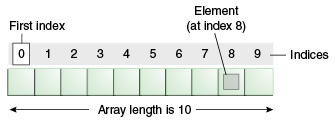Java Array
Normally, array is a collection of similar type of elements that have contiguous memory location.
Java array is an object the contains elements of similar data type. It is a data structure where we store similar elements. We can store only fixed set of elements in a java array.
Array in java is index based, first element of the array is stored at 0 index.
 Advantage of Java ArrayCode Optimization: It makes the code optimized, we can retrieve or sort the data easily.Random access: We can get any data located at any index position.Disadvantage of Java ArraySize Limit: We can store only fixed size of elements in the array. It doesn't grow its size at runtime. To solve this problem, collection framework is used in java.Types of Array in java
Advantage of Java ArrayCode Optimization: It makes the code optimized, we can retrieve or sort the data easily.Random access: We can get any data located at any index position.Disadvantage of Java ArraySize Limit: We can store only fixed size of elements in the array. It doesn't grow its size at runtime. To solve this problem, collection framework is used in java.Types of Array in java
There are two types of array.
Single Dimensional ArrayMultidimensional ArraySingle Dimensional Array in javaSyntax to Declare an Array in javadataType[] arr; (or) dataType []arr; (or) dataType arr[]; Instantiation of an Array in javaarrayRefVar=new datatype[size]; Example of single dimensional java array
Let's see the simple example of java array, where we are going to declare, instantiate, initialize and traverse an array.
class Testarray{ public static void main(String args[]){
int a[]=new int[5];//declaration and instantiation a[0]=10;//initialization a[1]=20; a[2]=70; a[3]=40; a[4]=50;
//printing array for(int i=0;i<a.length;i++)//length is the property of array System.out.println(a[i]);
}} Output: 10 20 70 40 50 Declaration, Instantiation and Initialization of Java Array
We can declare, instantiate and initialize the java array together by:
int a[]={33,3,4,5};//declaration, instantiation and initialization
Let's see the simple example to print this array.
class Testarray1{ public static void main(String args[]){
int a[]={33,3,4,5};//declaration, instantiation and initialization
//printing array for(int i=0;i<a.length;i++)//length is the property of array System.out.println(a[i]);
}} Output:33 3 4 5 Passing Array to method in java
We can pass the java array to method so that we can reuse the same logic on any array.
Let's see the simple example to get minimum number of an array using method.
class Testarray2{ static void min(int arr[]){ int min=arr[0]; for(int i=1;i<arr.length;i++) if(min>arr[i]) min=arr[i];
System.out.println(min); }
public static void main(String args[]){
int a[]={33,3,4,5}; min(a);//passing array to method
}} Output:3 Multidimensional array in java
In such case, data is stored in row and column based index (also known as matrix form).
Syntax to Declare Multidimensional Array in javadataType[][] arrayRefVar; (or) dataType [][]arrayRefVar; (or) dataType arrayRefVar[][]; (or) dataType []arrayRefVar[]; Example to instantiate Multidimensional Array in javaint[][] arr=new int[3][3];//3 row and 3 column Example to initialize Multidimensional Array in javaarr[0][0]=1; arr[0][1]=2; arr[0][2]=3; arr[1][0]=4; arr[1][1]=5; arr[1][2]=6; arr[2][0]=7; arr[2][1]=8; arr[2][2]=9; Example of Multidimensional java array
Let's see the simple example to declare, instantiate, initialize and print the 2Dimensional array.
class Testarray3{ public static void main(String args[]){
//declaring and initializing 2D array int arr[][]={{1,2,3},{2,4,5},{4,4,5}};
//printing 2D array for(int i=0;i<3;i++){ for(int j=0;j<3;j++){ System.out.print(arr[i][j]+" "); } System.out.println(); }
}} Output:1 2 3 2 4 5 4 4 5 What is the class name of java array?
In java, array is an object. For array object, an proxy class is created whose name can be obtained by getClass().getName() method on the object.
class Testarray4{ public static void main(String args[]){
int arr[]={4,4,5};
Class c=arr.getClass(); String name=c.getName();
System.out.println(name);
}} Output:I Copying a java array
We can copy an array to another by the arraycopy method of System class.
Syntax of arraycopy methodpublic static void arraycopy( Object src, int srcPos,Object dest, int destPos, int length ) Example of arraycopy methodclass TestArrayCopyDemo { public static void main(String[] args) { char[] copyFrom = { 'd', 'e', 'c', 'a', 'f', 'f', 'e', 'i', 'n', 'a', 't', 'e', 'd' }; char[] copyTo = new char[7];
System.arraycopy(copyFrom, 2, copyTo, 0, 7); System.out.println(new String(copyTo)); } } Output:caffein Addition of 2 matrices in java
Let's see a simple example that adds two matrices.
class Testarray5{ public static void main(String args[]){ //creating two matrices int a[][]={{1,3,4},{3,4,5}}; int b[][]={{1,3,4},{3,4,5}};
//creating another matrix to store the sum of two matrices int c[][]=new int[2][3];
//adding and printing addition of 2 matrices for(int i=0;i<2;i++){ for(int j=0;j<3;j++){ c[i][j]=a[i][j]+b[i][j]; System.out.print(c[i][j]+" "); } System.out.println();//new line }
}} Output:2 6 8 6 8 10

